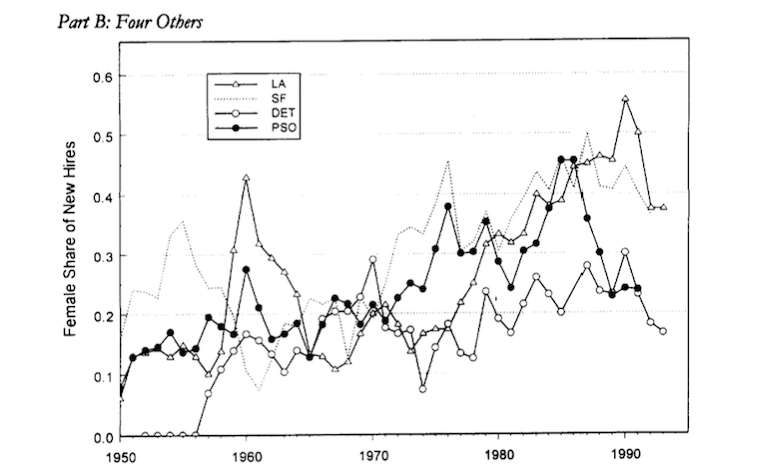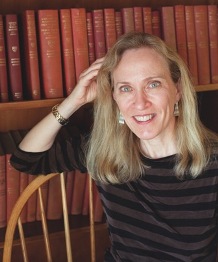Title of paper under discussion
Orchestrating Impartiality: The Impact of “Blind” Auditions on Female Musicians
Authors
Claudia Goldin and Cecilia Rouse
Journal
National Bureau of Economic Research, Working Paper 5903, January 1997
Link to paper (free access)
Overview
Carried out in the mid-Nineties by two economists now of international repute, this piece of research lighted on orchestral audition procedure as a tool to investigate sex-biased hiring, a phenomenon “alleged in hiring practices for many occupations”, but which is “extremely difficult to demonstrate”. Setting out to establish “whether women were more likely to be advanced and/or hired with the use of ‘blind’ auditions”, Goldin and Rouse looked at those candidates who had undergone both ‘blind’ (in which the identity of the candidate is concealed from the panel by a screen) and ‘not blind’ orchestral auditions, and found that “the screen increases – by 50% – the probability a woman will be advanced out of certain preliminary rounds” as well as enhancing “by severalfold, the likelihood a female contestant will be the winner in the final round”. Comparing the sex balance of various different US orchestra’s lineups from 1970-1996, the data suggested that “a switch to ‘blind’ auditions can explain between 30% and 55% of the increase in the proportion female among new hires and between 25% and 46% of the increase in the percentage female in the orchestras since 1970”.
The research centres on the use of ‘fixed-effects’ modelling, a branch of statistics especially enjoyed by economists and nicely explained here.

History of orchestral auditions in the US
The authors, writing in 1997, reflect on the fact that “until recently, the great symphony orchestras in the United States consisted of members who were largely hand-picked by the music director”, leading to an almost exclusively male constituency. Things changed in the 1970’s and 80’s with jobs being more widely advertised and audition committees expanding to include orchestral members other than just the conductor and section principal. Some orchestras were more progressive in this field than others: Boston Symphony Orchestra introduced a screened preliminary round as early on as 1952, whereas at the time of this paper (1997) the Cleveland Orchestra still offered no ‘blind’ audition rounds. Such an era of change in orchestral audition procedure gave our researchers an ideal set of data with which to investigate whether a switch to ‘blind’ auditions might have revealed a tendency towards sex-bias in ‘not blind’ auditions.

Sex compositions of US orchestras
Looking back over the years at the composition of the ‘Big Five’ US Orchestras (the Boston Symphony, Chicago Symphony, Cleveland, New York Philharmonic and Philadelphia), the authors found that none had more than 5% women until 1965, and none more than 10% by 1980. But at some point, different for every orchestra, the female percentage rose by a degree that led Goldin and Rouse to comment “the increase in women in the nation’s finest orchestras has been extraordinary”, and “even more remarkable” because “turnover in these orchestras is exceptionally low”.
Graphs describing the rise in female membership of these orchestras, plus four more (LA Phil, San Francisco Symphony, Detroit Symphony and Pittsburgh Symphony) are given below:


Also described, in the following graph, is the percentage of women as new hires over these years:


The authors postulate that perhaps the orchestral marketplace suddenly became flooded with female candidates, accounting for this increase in female new hires. So they looked at the Juilliard School of Music, a typical provider of audition-ready instrumental graduates – was it suddenly “producing considerably more female students in the 1970’s”? This graph suggests not, except perhaps in brass instrumentalists:

If the increase in female orchestral musicians can’t be explained by an increase in supply then perhaps, suggest the authors, it’s down to changes in the hiring procedure, changes that would mitigate against any inherent sexism in the music profession. Such sexism was widespread according to the authors: “Many of the most renown conductors have, at one time or another, asserted that female musicians are not the equal of male musicians. Claims abound in the world of music that “women have smaller techniques than men,” “are more temperamental and more likely to demand special attention or treatment,” and that “the more women [in an orchestra], the poorer the sound.” Against this background, the authors argue, “a screen that conceals the identity of the musician auditioning, could eliminate the possibility of discrimination and increase the number of women in orchestras”.
What makes orchestras introduce ‘blind’ auditions?
As an adjunct to their main research aims, Goldin and Rouse were keen to investigate a couple of factors commonly thought to make introduction of screen adoption more likely: 1) a higher percentage of women already in the orchestra and 2) fewer ‘oldtimers’ (ie a lower average length of tenure of all members).
To their surprise they found to the contrary: “orchestra sex composition did not influence screen adoption” and “stability of tenure may have increased its likelihood”.

Main study
For their central piece of research the authors gathered data from two sources: audition records and orchestral lists (‘personnel rosters’).
The data from audition records (shared by eight major US symphony orchestras) was from a sample of 14,133 individuals taking part in 592 audition ‘segments’ (prelims, semi-finals and finals). Each segment had to involve at least one male and one female contestant – all-male auditions were excluded from the analysis.
An cursory look at the audition data would seem to suggest that “women fare less well in ‘blind’ auditions than otherwise” – their success on average in advancing through an audition segment is slightly higher when that segment is ‘not blind’.
But perhaps, the authors argued, “the adoption of the ‘screen’ lowered the average quality of female auditioned in the ‘blind’ auditions.” It’s crucial therefore to research instead how specific women fare in a ‘blind’ compared to a ‘not blind’ process; only then can you investigate the true effect of screening on audition results. In the words of the authors “Only if we can hold quality constant can we identify the true impact of the screen”.
This approach – to compare the ‘blind’ and ‘not blind’ auditions of individuals – was straightforward enough; plenty of musicians in their data set had entered at least one audition that was ‘blind’ and one that was not. When these musicians’ audition results were analysed a “very different story” emerged: “The success rate for women competing in ‘blind’ auditions is markedly higher than in those that were ‘not blind’.” In all, “for preliminaries […] the ‘blind’ audition increases the likelihood that a woman will be selected by about 11 percentage points. For female musicians who made it to the final round […] the screen increases the likelihood of their winning by about 30 percentage points.”

Analysis of the data from orchestral lists came to similar conclusions. Going through the changing rosters (personnel lists) of eleven orchestras year on year, the researchers tabulated the sexes of newly hired players. Knowing the year in which each of those orchestras introduced screened auditions meant they could estimate the increase in likelihood that a female musician would be hired if the audition was ‘blind’ compared to ‘non blind’, and so declare that ‘blind’ auditions were responsible for 25% to 46% of the increase in the proportion of women in orchestras seen from 1970 to 1996. And looking directly at the hiring process, the introduction of screened auditions could explain 30% to 55% of the increase in the proportion of women amongst new hires.
Goldin and Rouse muse on why there was “disparate treatment of female musicians before the screen was used”, reflecting that perhaps anxieties existed over whether women would invest the same amount of time as men in their orchestral job. So they looked at sex differences in 1) leaves of absence (including maternity) and 2) length of tenure. Using the roster sample from 1960 to 1996 they found that “the average female musician took 0.067 leaves per year whereas the average male musician took 0.061, a difference that is not statistically significant, and that their length of leave was trivially different. Tenure differences were also small and some specifications show that women had greater, not fewer, years with an orchestra, given their starting year and orchestra.” In all “Turnover and leaves of absence do not appear to differ by sex and his should not have rationally influenced hiring decisions.”
in conclusion, the authors remind us that “impact of a ‘blind’ procedure is toward impartiality and the costs to the […] orchestra […] are relatively small. We conclude that the adoption of the ‘screen’ and ‘blind’ auditions served to help female musicians in their quest for orchestral positions.”
Coda
Dvořák’s Symphony No. 8 in G Major
Boston Symphony Orchestra, conducted by Shi-Yeon Sung
(recorded live in concert on January 5, 2019)